Articles
Managing Household Pests the Old-Fashioned Way:
Defenses Against Pest Damage in the Eighteenth and Nineteenth Centuries
Abstract
Housekeeping during the eighteenth and nineteenth centuries required protecting valuable home furnishings and furniture from damage by household pests without modern insecticides. Housewives and housekeepers from long ago used preventive methods, some of them similar to modern museum pest management. This paper reviews the methods housewives used and discusses their effectiveness in light of what is known today about museum pest management. It suggests that many historic methods were very effective.
Résumé
Au cours des XVIII et XIX siècles, prendre soin d'une maison signifiait protéger le mobilier et les articles d'ameublement précieux contre les dommages que pouvaient causer les ravageurs, sans l'aide des insecticides modernes. Autrefois, les maîtresses de maisons et les domestiques recouraient à des méthodes préventives, dont certaines ne sont pas sans rappeler les usages modernes dans les musées. Cet article passe en revue les méthodes employées par ces ménagères et en examine l'efficacité à la lumière de ce qu'on sait aujourd'hui de la lutte antiparasitaire dans les musées. Il laisse supposer que bon nombre de méthodes historiques s'avéraient très efficaces.
1 Managing a household in the eighteenth and nineteenth centuries required considerably more effort than it does now. Old-time housewives used traditional housekeeping methods to care for family possessions and administer homes. Some notable family residences are now historic house museums that survived due in large measure to the efforts and administration of women long ago. Many of these homes are fabulous cultural resources accessible today because of the managerial accomplishments and preservation skills of housewives and female housekeepers.
2 A significant challenge they encountered was protecting possessions and home furnishings from a variety of household pests. Studying old-fashioned home pest management from a by-gone era is relevant and timely. The controversy surrounding pesticide use, its possible long-term health risks and contamination of the environment is reshaping pest control.1 Many in the museum professional community believe some research suggests modern insecticides and fumigants damage museum objects while threatening the safety of curators and museum visitors. Museum curators are also troubled that use of modern synthetic insecticides that remain with the object and will not biodegrade has forced them to pass along tainted artifacts to future generations.2
3 The distressing realities of a deepening insecticide crisis support pest management techniques relying less on toxic substances. "Integrated pest management" seeks to mitigate the origins of pest problems rather than continue dependence on chemical remedies. Addressing the origins of pest problems, control strategies develop from knowledge about the life-cycle of individual pests. Control then concentrates on limiting pest access to food and mitigating circumstances encouraging their continued survival.3 Museum curators who adopt these tactics may be surprised that housewives in the eighteenth and nineteenth centuries used some similar methods to protect vulnerable possessions from destruction by pests. What they did is relevant to present collection management concerns in historic house museums and could possibly form a subject for interpretive programs.
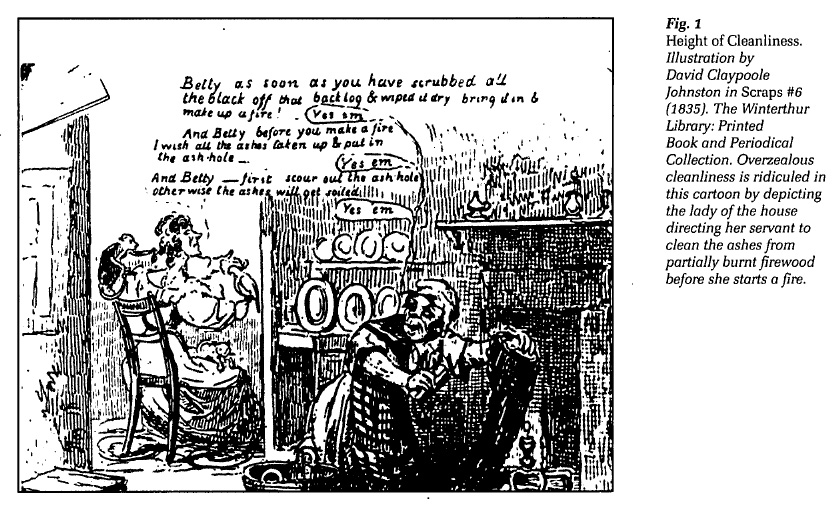 Display large image of Figure 1
Display large image of Figure 14 Whether pest intruders were nuisances to the family's bodies, spoilers of the family's food or threatened the ruination of furniture and furnishings, house pests have always prompted housewives to action. A portion of housekeeping work was devoted to battling various unwelcome intruders into the family's living space. Curators need not deal with all the pest problems old-time housekeepers faced because people no longer live, eat and sleep in the household-turned-historic museum.
5 Housework has always meant cleaning. American housekeepers in the eighteenth and nineteenth century aspired to keep their homes very clean.4 Cleanliness provided a pleasurable and refined ambience at home, promoted health through conquering dust and dampness and resulted in a soul-satisfying order.5 While it is difficult to understand the cleanliness imperative in all its social and cultural ramifications, some contemporaries grasped the effects of cleanliness on pest control. Thomas Webster suggested in 1857 that cleaning allowed a household "exemption from troublesome insects." He promoted one of the basic tenants of modern museum pest management — that cleanliness made the interior of the home less resemble outdoors and less likely to support insects.6
6 Insisting on cleanliness in historic house museums restores it to an authentic past that also meets present-day standards of modern, museum integrated pest management. Present-day curators — as descendants of old-time housekeepers — must simultaneously preserve the historic house museum and its relics, while providing visitors an authentic revelation of its history. Pest management is difficult in old houses because of the many nooks and crannies harbouring hidden fabric lint, dust bunnies and miscellaneous organic nutrients, all consumable by a profusion of household pests that may also attack museum artifacts.7 Canadian Conservation Institute publications emphasize cleanliness as the single most important factor in successful modern museum pest management.8 Cleanliness in historic house museums actually continues a tradition begun by old-time housekeepers.
7 Accurate portrayals of furnishing conventions from the past also facilitates cleanliness in historic houses. Throughout the eighteenth and nineteenth century, furnishing conventions aided housewives in their cleaning chores. During the period, valuable and fashionable parlour furniture was set against walls. Tables and chairs were brought out from their positions, used and moved about. Many furniture items were equipped with casters of brass, wood or leather to facilitate easy transport about the room. When not in use they were returned to walls, a necessary safety measure in dimly lit interiors.9 The resulting open space at the centre of rooms aided housekeeping; the portability of furniture made cleaning underneath easier and therefore it was accomplished more frequently. Floors were waxed to a high shine, as was furniture; some walls were varnished, glossy paints were used and floor coverings were made of glazed chintz, all of which helped prolong and facilitate cleanliness.10
8 Crucial to household maintenance in the eighteenth and nineteenth century was the management of the various household spaces with their furnishings within. Some spaces contained more valuable and vulnerable items than others. By 1830, an emerging American middle class was beginning to acquire carpets, elaborate curtains and upholstered furniture that before 1800 had been the privilege of only the affluent. Everyone aspired to have a carpet by this time. It might be a Brussels, Axminster, Wilton, or common ingrain, but it became a conspicuous feature of parlours during the first half of the nineteenth century.
9 Beginning in the 1830s, an upholstered sofa had become the centrepiece of parlour seating. Often a duo of sofas upholstered in haircloth were prominent in parlours. They were accompanied by as many as a dozen side chairs and armchairs with damask seats. Damask curtains with colour-coordinated squabs, colourful "Turkey" carpets and even fabric-covered fire screens were parlour furnishings invariably composed partially of wool or animal hair. The elegant simplicity of eighteenth and early-nineteenth century interiors gradually gave way to a fondness for accumulation toward the end of the nineteenth century. Chairs deepened and became more luxurious. Lounges, ottomans, hassocks and footstools swallowed floor space and pushed side chairs into chambers and other spaces as the drawing room acquired an inordinate conglomeration of sumptuous and dainty furnishings and colours,11 much of it quite edible to a variety of pests.
10 Additional susceptible textiles, mainly woolens and linens both homespun and commercially obtained, were stored in chests of drawers, double chests, bureaus, presses, wardrobes and trunks. Family clothing, bed and table linens, quilts, coverlets, towels and clouts were stored in these types of furniture wherever security and convenience prompted it. The keys to locked drawers, trunks, doors to storage furniture and closet spaces, usually hung suspended at the housewife's waist or neatly held in a small leather pouch tied there. She was simultaneously in charge and responsible for the welfare of these precious family possessions. Household furnishings made from natural materials, once-alive plants and animals, were all likely sustenance for a large assortment of fungi and insects. Natural decomposition and disintegration were sources of profound anxiety to old-time housewives. Clothing and interior furnishings were expensive expressions of position and self-image, safeguarding them was an important demonstration of the housekeeper's domestic obligations and skills.
11 Spring housecleaning was crucial to housewives' preservation strategy. Greasy soot deposited by long months of winter fires and lamps was an ugly reminder of winter's confinement, marring interior structural features and home furnishings. It must be cleaned away, preparing the house for the widely divergent temperatures of summer and the onslaught of insect pests. To accomplish this the house underwent a house-cleaning of gigantic proportions and incredible effort. Chores during spring cleaning included sweeping chimneys, washing windows and frames, dusting wallpaper, washing woodwork, whitewashing walls, cleaning out closets, and scouring floors. Spring cleaning began with the upper floors and came down, whitewashing walls as it proceeded. Rooms were stripped of furniture, which was taken outside for airing and sunning.12
12 Curtains were taken down, carpets taken up, shaken out, brushed and aired outside, afterwards folded with camphor or tobacco, sewn or penned inside clean white sheets or tablecloths, and stored in chests or trunks. Only woolen curtains were taken down for the summer; muslin under-curtains were washed, bleached, ironed and rehung. These traditional actions also accomplished pest management goals. Clothes moth larvae and eggs are very fragile and may be dislodged by brushing and shaking susceptible materials outdoors. Adult female moths lay their eggs directly on potential food for larvae when conditions are most favourable, usually around 24°C and at least 75 percent relative humidity. Housekeepers may not have known the details of what they were accomplishing, but woolens had been taken outside and beaten since the Middle Ages. The effectiveness of these actions had entered housekeeping folklore generations before and was seldom questioned.
13 Many vulnerable furnishings were stored for the summer and placed inside insect barriers. The necessity of blocking access by pests to susceptible items is recognized today as a basic premise of modern museum pest management. Housekeepers folded items, sewed or pinned them inside linen, silk, or paper enclosures, then put them inside a trunk or chest. These were preventive measures devised to protect furnishings during periods when climatic conditions were likely to favour moth activity. Modern materials allow a much tighter enclosure and more effective barrier than old-time housekeepers could manage. However, recent research finds plain brown craft paper sealed with adhesive tape is an effective obstruction to moths because they cannot eat through the paper.13
14 Newly hatched moth larvae can enter gaps as small as 0.01 mm and female moths seek cracks in which to lay eggs. Eighteenth- and nineteenth-century housekeepers lacked modern entomological information, but they knew larvae did the damage, while flying moths laid the eggs. One housekeeping manual sent housewives chasing flying moths inside the house, trapping them under a glass and killing them.14
15 Since storage in trunks did not always provide a successful barrier against moths, housekeepers resorted to repellents. Camphor, shredded tobacco, cracked black pepper, aromatic herbs, dried rose leaves and lavender were scattered in drawers and trunks in hopes of preventing insect damage. Modern pest management strategies emphasize the importance of an effective barrier in storage rather than relying on repellents but throughout history various materials have been employed as repellents, some effectively, others not. Camphor, a natural product derived from the camphor tree, has been in use since ancient times and is still sold, although it is synthetic camphor made from pine turpentine. Rosemary, marjoram, sage and lavender had the same natural repugnancy to insects as camphor.15
16 "Natural insecticides," were used as repellents by early housekeepers. Called "botanicals," in modern pest-control jargon, one of the earliest was dried and crushed chrysanthemum flowers. Nicotine, pyrethrum, rotenone, and ryania are modern botanicals.16 Camphor, both repellant and toxic to insects, was recognized as the best of the repellents available to early housekeepers.17
17 Although summer storage was beneficial to vulnerable home furnishings, not all authorities agreed on the details of this strategy. Eliza Leslie's domestic manuals were sufficiently well received to require numerous editions during the middle of the nineteenth century.18 She had misgivings concerning the practice of removing furnishings outside to sun and air even though it was the only place many items could effectively be brushed, beaten and spread out for cleaning. Some cautioned that prolonged exposure in the sun risked possible fading, but Leslie believed moths got into things while furnishings were outdoors during spring cleaning. To accomplish more unpleasant, sooty and messy spring cleaning tasks like chimney sweeping and whitewashing walls, she recommended furniture and furnishings be piled in the center of the room and covered with old rugs. When placing textiles in storage, she would brush, shake them out, wrap them tightly in linen with lumps of camphor, handfuls of hops or "shreds of good tobacco."19
18 Housewives were not aware that at least some of the threat to their woolens and particularly their furs derived from carpet beetles rather than moths. "Moths" are all that is discussed in written sources from the period. Carpet beetles and moths consume the same materials. Moths shy away from bright sunlight and larvae even drop off sunning woolens to avoid the bright light.20 Carpet beetles, however, are attracted to bright light; more importantly, before laying eggs on food sources for the larvae, carpet beetle adults feed on nectar and pollen from flowering plants.21 Contemporaries of Eliza Leslie could not have known the details of the behavior patterns of moths and carpet beetles. The larvae are very similar but carpet beetle adults are much smaller and less obtrusive than adult moths. Even while unaware of the carpet beetle threat, the preservation procedures historic housewives followed — vigourous brushing outside in sunlight, maintaining cleanliness, and summer storage inside barriers with repellents — was the inherited experience of numerous generations of housekeepers and it was generally very effective.
19 As early as the seventeenth century, American cabinetmakers used white cedar in furniture drawers to repel insects. The long-extolled value of cedar chests in repulsing moths is probably due to their tight-fitting lids, not the cedar oil in the wood. Cedar lumber loses its potency within a few years of cutting.22 Designers of storage systems ranged far and wide for an infallible technique for preserving woolens throughout the summer. One suggestion possesses equal degrees of novelty and ingenuity while coming very close to accomplishing the goal of completely blocking insect access. It proposed using an empty whiskey hogshead — a barrel — filling it with carpets, blankets, curtains, wool clothing, and furs, then nailing on the "head," or lid. There the woolens and furs remained until, on a clear autumn day when the danger was over, they could be brought out and aired of the smell of whisky.23 The system's virtue was that woolens entered the cast clean, remaining tightly sealed inside an impenetrable barrier until brought out when conditions were safer in cold weather.
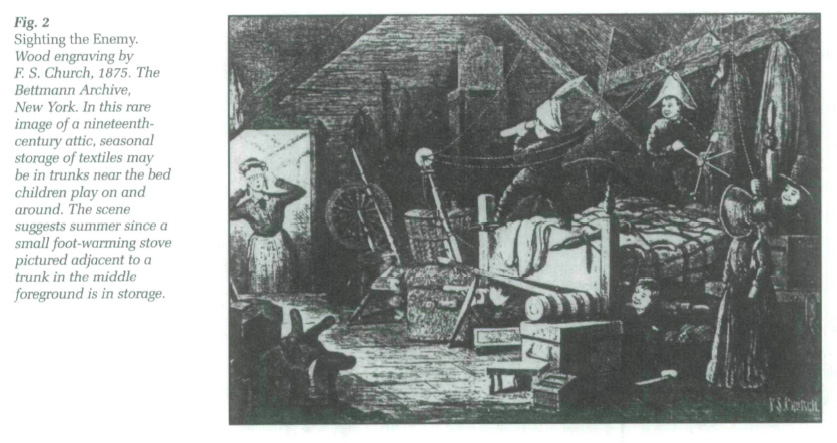 Display large image of Figure 2
Display large image of Figure 220 Some museum curators believe that housewives might have fared better with their storage systems had they not insisted on regularly inspecting stored textiles, removing them, shaking them out, and airing them periodically throughout the summer. Often, they found insect damage in the process because pests gained entrance to storage during previous inspections.24 If some spring cleaning procedures courted disaster, others were fortunate indeed. The garret or attic was often used for storage of outmoded, outgrown, outsized and out-of-season items. In summer, it was crowded by the addition of fire screens, paper-wrapped andirons, dismantled stoves, trunks of bed hangings and window curtains, chests of winter clothing and rolled-up carpets. Uninsulated attics in regions where outside temperatures climbed to the nineties provided an unintended heat treatment to stored woolens. Above 35°C moth adults, larvae and eggs begin to die, depending on the duration of exposure. Eggs are the most heat-resistant, but after a week at 37°C, moths at all stages die.25 Heat treatment was also effective against carpet beetle larvae if temperatures were slightly higher. Trunk storage often was sufficient to prevent carpet beetle larvae from entering, provided eggs were not brought in from outside and the trunks were not "hair trunks," those made from leather with the animal's hair still on the hide.26
21 Carpets were expensive enough to warrant special attention in their care and maintenance. Routine cleaning was accomplished by sweeping with damp tea leaves saved from the kitchen for that purpose. Grease stains had wet clay smeared on them, scrapped away when dried. Major cleansings with soap and water often occurred when carpets were in place on the floor. Removing carpets for shaking and beating and possible summer storage involved considerably more effort than other woolens. Carpets in American parlours were usually stretched wall to wall and nailed to the floor with numerous small tacks. Tightly stretched carpets did not clump under furniture as it was dragged about. Carpets had to be taken up witii a small tool, a "carpet fork," used both for prying out tacks and for stretching the carpet edges when putting it back in place.27
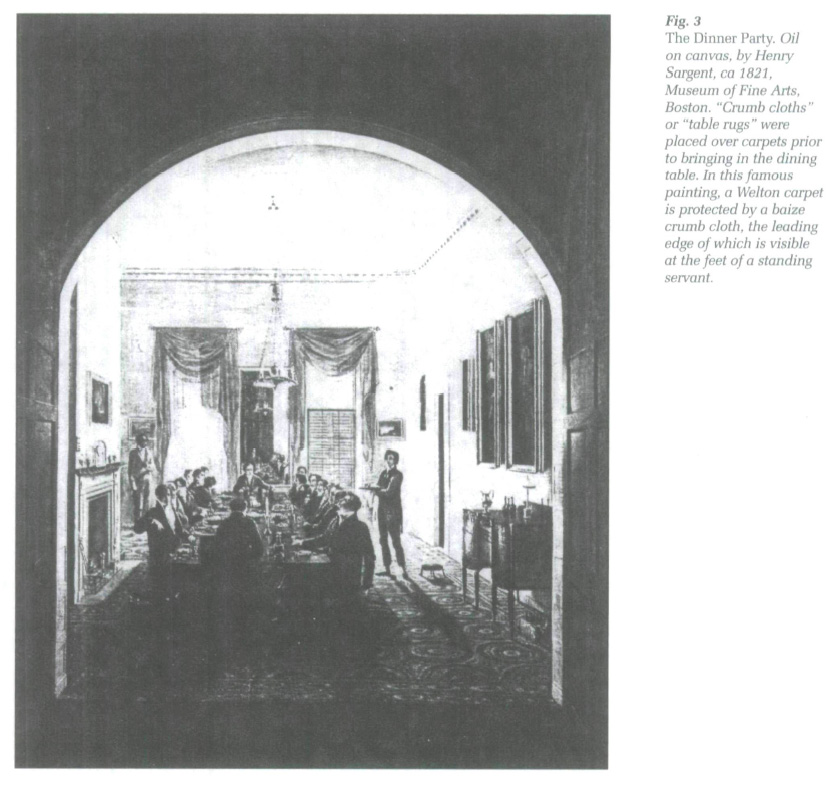 Display large image of Figure 3
Display large image of Figure 322 Carpets might be placed in storage and replaced with straw mats or returned to the floor during the summer. Eliza Leslie recommended hiring a man with a cart to take all the carpets in the house up from the floor and transport them to a vacant lot where they could be beaten, shaken out and swept clean. While the carpet was away, wooden floors were swept and scrubbed. Floors made of poorly seasoned wood often shrank leaving cracks at the walls and between boards. These areas became repositories of lint and organic debris — breeding grounds for moths and carpet beetles, access holes for cockroaches and mice. Often, structural cracks allowed pest infestations to transfer to the carpet when it returned. Removal provided an opportunity to thoroughly scrub the cracks and put something beneath the carpet before it was returned. Some preferred cedar branches, others shredded tobacco or cracked black pepper, all as deterrents to moths. Some domestic manuals called for a bed of straw under carpets, others coarse paper, still others, straw matting. Eliza Leslie preferred drugget, a coarse, durable cloth sometimes used under dining tables as a crumb cloth.28 Some of these materials might also serve as barriers to pest transfer from the lint deposits in floor boards. Today, curators use water-filtered vacuum cleaners to thoroughly clean structural cracks in historic houses that might harbour moth and carpet beetle larvae and permit infestation of carpets or other collection items nearby.29
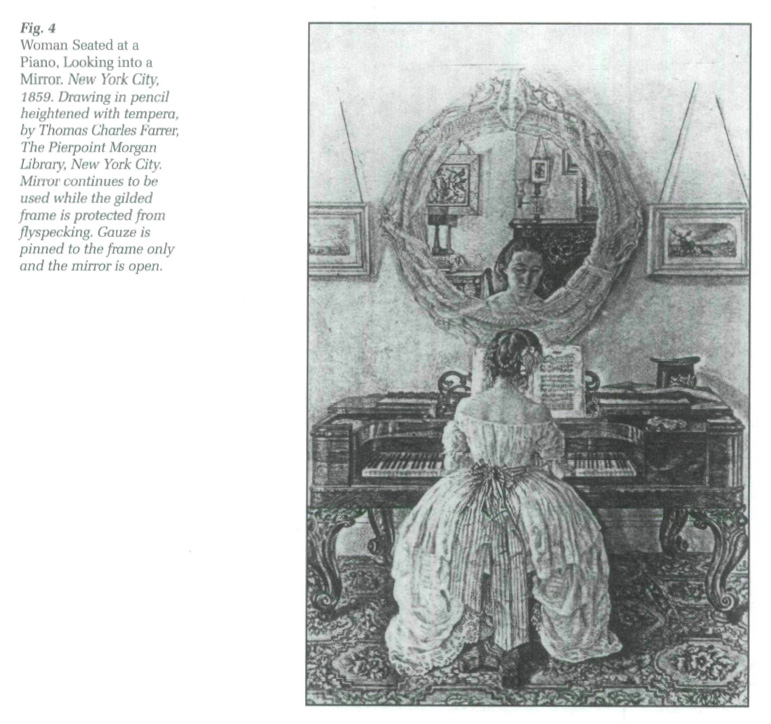 Display large image of Figure 4
Display large image of Figure 423 Americans continued to be adaptable in their dining arrangements far into the nineteenth century and eating could ensue at tea time or during major meals directly over carpets. In preparing the room for a meal the first step was to place the table rug or "crumb cloth," then bring in the table, often from the central hallway where it was sometimes kept. The term, "crumb cloth" came into general use in the mid nineteenth century. Green baize, a course woolen material, was often employed to protect carpets from food and beverage spills. The practice is well documented in inventories, housekeeping manuals and paintings from at least as early as the late eighteenth century.30 One would be mistaken to suppose that the use of crumb cloths was a proactive measure against pest damage planned with the knowledge that moths and carpet beetles attack woolens stained with food and beverages.31 As with other fortuitous actions during the period, it is unclear Uiat contemporaries fully understood or made the necessary connection for this type of pest management information to enter the folklore of housework. Cleanliness also derived from other cultural and social imperatives.
24 During summer, valuable upholstered seating furniture was given fitted, light cotton or linen covers, often with ties in the back resembling modem hospital gowns. Chairs, chair cushions, ottomans, and sofas had fitted cloth cases made to order. Upholsterers allowed customers to specify either loose or tight-fitting covers. Before they were fastened, crumpled camphor was dropped between covers and upholstery to be occasionally replenished throughout the summer.32
25 Smoky residues from winter fires and lamps and pin-dot flyspecks disfigured paper engravings hung without glass fronts. Gilded mirror and picture frames and other furniture with light, painted finishes were also specked by flies. During spring cleaning, pictures and looking glasses were cleaned of winter smoke and the accumulation of flyspecks. One recipe from the period called for cleaning mirrors with a splash of gin and gilded frames with water boiled with onions and leeks. Once cleaned, gilded frames were covered with gauze, muslin or tissue paper held in place with small pins. Lamps and chandeliers had gauze bag-like covers tied with ribbons.33
26 Furniture covers and gauze fly shields allowed housewives to protect furniture and furnishings from pest damage while continuing use during summer. Homes were not an effective barrier to pest entry, especially in summer when personal comfort demanded ventilation. Increasing the ability of structures housing cultural resources to limit pest access and activity is basic modern museum pest management. Historic housekeepers did recognize the need to make changes to deter pests from entering the home. Eliza Leslie advised that cellar windows "be secured on the outside with wire netting, to prevent the entrance of rats from without." She also suggested "listing" doors by nailing laths or strips of wood covered with baize at the bottom of exterior doors. This was a winter-time expedient to keep the cold out, but more elaborate permanent door sweeps were used. In 1772, an invoice of goods from London bound for a merchant in Williamsburg, Virginia, mentioned "Yellow Gilt" and "White Silvered" leather "listing" for the bottom of doors with nails to match. Leadier was used in England to weatherstrip doors and the practice was common in America far into the nineteenth century.34 Historic house museums could benefit from "listing" doors for controlling insects that crawl under doors and rodents that frequently enter beneath ill-fitting doors.
27 Architectural elements common on domestic dwellings in the eighteenth and nineteenth centuries provided partial barriers to pest entry from outside. Slatted exterior shutters, also called "blinds," first appeared on houses in America in the mid-eighteenth century; by the mid-nineteenth century, they were universal. When shutters covered window openings they enhanced summer comfort by allowing air to enter while protecting the interior from destructive and warming rays of the sun. Louvres also stopped rain and allowed ventilation. Dust and sand was inhibited from blowing in the house. Shutters as blinds enhanced privacy, let in air, and, while not totally stopping flies and mosquitoes, discouraged free entry. It is a misconception to think shutters were only closed during inclement weather; instead they remained closed throughout most of the sunny summer.35 Entry halls often had "pocket shutters," that pulled out from inside walls while main doors stayed propped open.
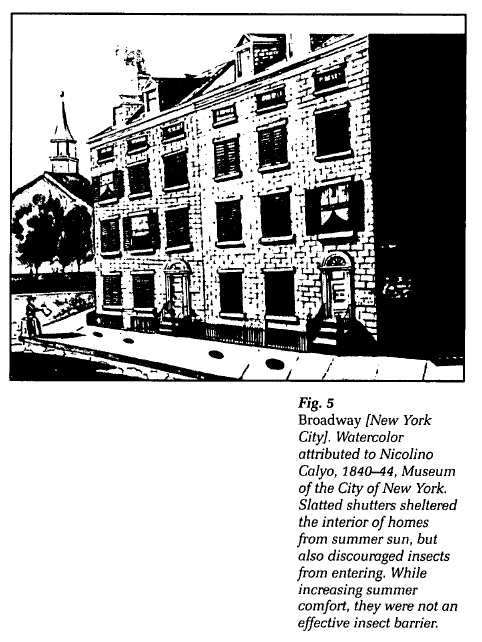 Display large image of Figure 5
Display large image of Figure 528 Shutters were not an effective barrier for insects. But fine-mesh screening over exterior openings had great potential as a pest management control device. However, initially the use of screening had more to do with providing personal comfort and only secondarily to protect household furnishings from damage by insect pests. Screening, as a permanent architectural element, promised to be a very effective barrier to isolate the home's interior from easy access by all insects, not just mosquitoes and flies. The practice of screening windows and doors evolved from the use of mosquito netting, which probably came to the southern United States from the West Indies as early as the seventeenth century. Colonists to the Caribbean islands quickly learned measures to counter mosquitoes like clearing tropical growth near homes and making smoky outside fires to discourage them. The term "pavilion," was used in the seventeenth century to describe a cone-shaped netting canopy tied to the ceiling over bedsteads to help prevent mosquitoes from disturbing sleep. Pavilions were adapted in various ways to bedsteads and used to enclose smaller settees, couches, easy chair beds and hammocks.36
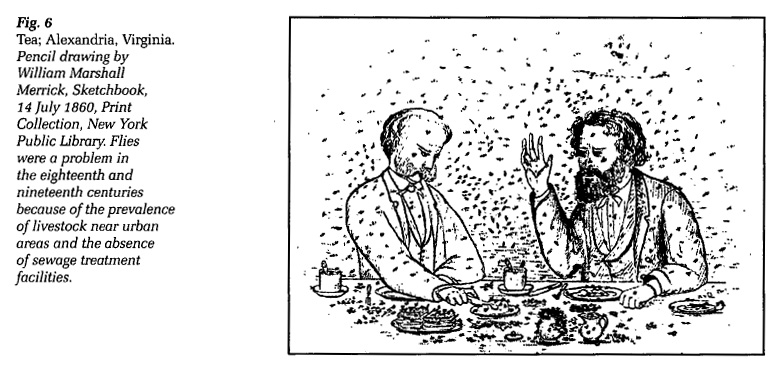 Display large image of Figure 6
Display large image of Figure 6 Display large image of Figure 7
Display large image of Figure 729 Adaptations of pavilion gauze covers for other uses was inevitable in southern states. Benjamin Latrobe, while traveling to New Orleans, noticed that men like himself who did sedentary work in their offices had improvised frames covered with gauze large enough to comfortably cover a table and chair, where they worked with perfect safety from mosquitoes late into the night. Latrobe recognized the commercial possibilities of screening: "There is room to carry this mode of security to a much greater extent and render it applicable to companies, as well as to adorn it with elegance."37 Screens were used in Virginia in the 1730s in plantation homes on the York River. Troublesome "muskettos" came from nearby wetlands. Wire and gauze screening solved the problem.38
30 Acceptance of screens inserted in windows was not confined to the southern states. Thomas Fessenden, editor of the New England Farmer, advised readers in 1826 to adopt screens as a cheap and effective method to control "bold, bloodthirsty and persevering," mosquitoes. It was a do-it-yourself project: "Make light frames of the size of the lower sashes of the windows in the bed chamber; cover them with millinet, and place them in the place of the lower sashes.. .and shut the doors."39 By the mid nineteenth century, it was common to incorporate window screens in house plans specifically to counter the "flying torments" in bed chambers. The type of protection developed was portable and intended to be added to chamber windows from the inside. Called "folding-frames," they were lightly made, and covered with netting made from wire, gauze, or muslin.40 As far back as the early eighteenth century, it was common to have a small drawer fitted in a recessed space below windows.41 Screen frames were perhaps made to fold so they would fit in this drawer. By mid-nineteenth century there were proposals that "a very fine wire cloth" was suitable for use on the home's exterior to both exclude insects and diffuse light like shutters.
31 Window screens were not used more extensively because of a growing concern in the nineteenth century that they impeded the flow of fresh air into the home.42 One ingenious proposal to defuse objections that screens inhibited ventilation was for Flyguards. When placed in windows they allowed ample air to enter windows since the mesh had black threads arranged in a grid an inch apart. Claims that flies feared "entangling their wings" and would not fly through them went unproven.43
32 Many housekeepers so feared flyspecking of furnishings they kept parlours closed up entirely and opened them in summer only for special occasions. The parlour remained closed and outside the normal activities of the family. When it was opened, housewives felt justified since it was cool inside for their guests, the hot outside air having been excluded as was light since shutters and window sashes were both kept closed.44 Many housekeepers would not allow screens in dieir windows, believing they impeded the free flow of air, and preferred closing the parlour. While it was effective in excluding pests, leading housekeeping critics condemned the practice as unhealthy.
33 Screens were accepted with reluctance and eventually became a more attractive alternative when measured against the "unhealthy" practice of leaving the parlour unventilated entirely. Catherine Esther Beecher, sister of Harriet Beecher Stowe, an influential housekeeping advisor and style-setter in nineteenth-century America, gave her final, though grudging approval to screens in 1873: "Shut out flies with wire netting in open windows, and also doors of the same. It cost much less than ill health and mournfully darkened rooms."45 By 1875, large companies were meeting the growing demand for screen windows and doors that had formerly been met by small local fabricators and do-it-yourself farmers.46
34 Screening on the windows and doors of historic house museums is not an unwarranted modern intrusion if it was used in the early eighteenth century and throughout the nine-teenth century. Screening is a pest management preventive measure to decrease insects that damage collection items and help preserve historic structures as well. Screening out the outdoor ecology is good modern pest management and, since it has historic precedence, good museum interpretation. Once an effective barrier to pests is established, curators monitor the interior of historic houses by various methods to learn what is crawling or flying indoors, then develop an action plan to further reduce the total interior insect population.47
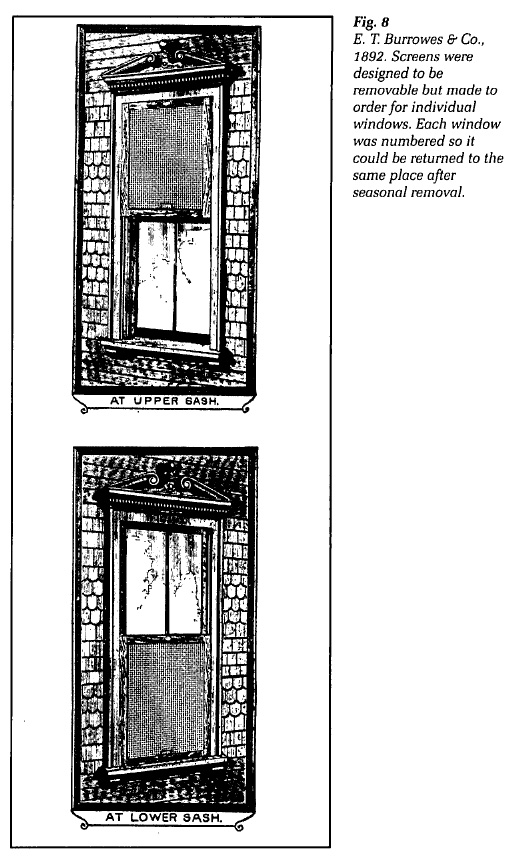 Display large image of Figure 8
Display large image of Figure 8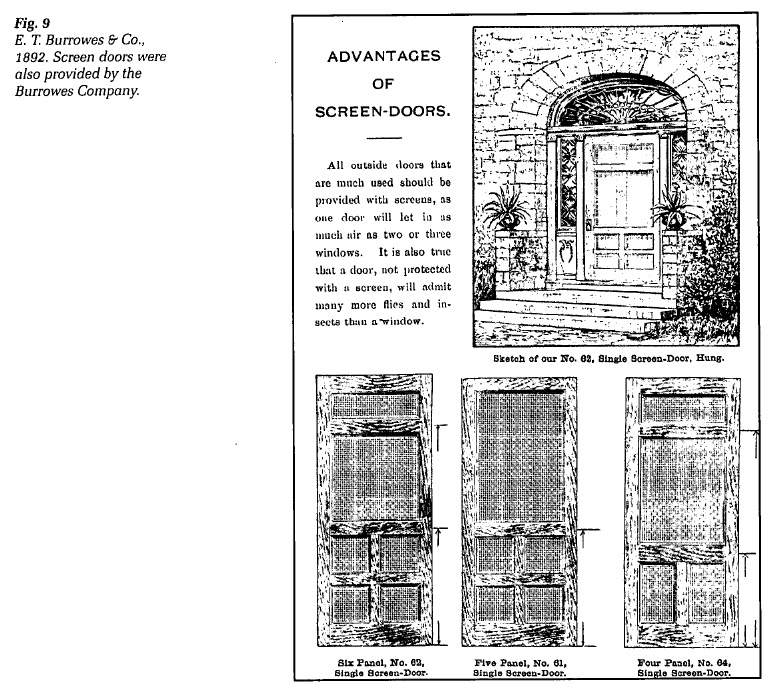 Display large image of Figure 9
Display large image of Figure 935 The interior environment can be rendered less conducive to pests by prohibiting the entry of materials from the natural environment that may either harbour insects, or serve to provide a source of food or create circumstances conducive to pest activity. Controlling consumption of food by humans inside the museum and regulating what comes into the museum environment avoids the introduction of alternative sources of support for pests.48
36 Modern museum pest management emphasizes making choices that reduce risks to museum collections and historic structures. Blocking pest entry by using screening is one choice, excluding elements of the outdoor ecology that might aid pest survival is another. Old-time housekeepers removed and stored woolen bed curtains during spring housecleaning. Removing curtains offered an opportunity to disassemble beds and, after washing the joints with soap and water, the whole bedstead was completely varnished. Bedsteads often were made with turnposts that allowed easy disassembling using a "bed wrench," or "bed key." They were sometimes dismantled as often as once a week throughout the summer to have their joints soaped. "Chintzes or [bed] bugs" resided in bedstead cracks and crevices.
37 Eighteenth and nineteenth century bedsteads held a large sack made of ticking and stuffed with about eighteen kilograms of feathers. Mattresses were firmer versions of feather beds containing wool clippings, straw, curled horse-hair and cotton. Feathers in beds may have been swan, elder, or goose down or ordinary chicken feathers. Bedbugs are blood-feeders known to feed on humans and many species of birds and bats. The experiences of old-time housewives with bedbug infestations is an object lesson in the risks of moving an outdoor ecology into a home. Bedbugs plagued old-time housekeepers not for lack of cleanliness, but because of nearby chicken houses and feather beds. Battling bedbugs was an extremely frustrating experience for housekeepers but it was one they were likely to lose so long as bedding came from nature.
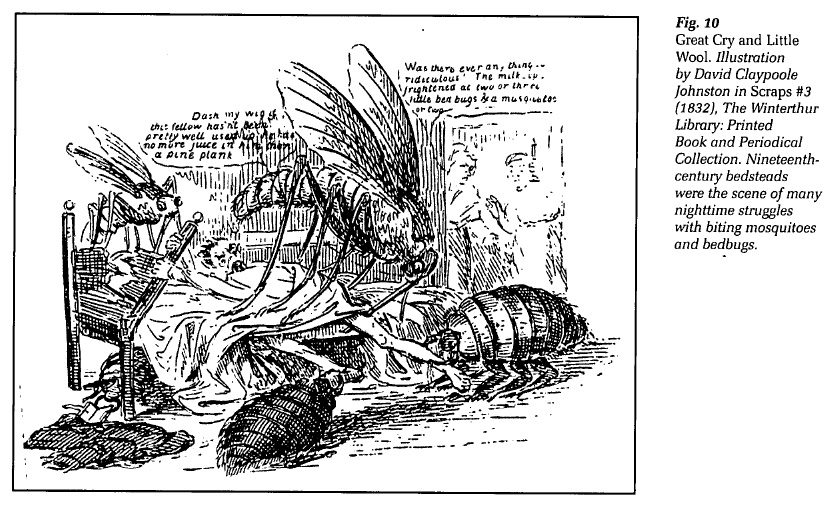 Display large image of Figure 10
Display large image of Figure 1038 Common bedbugs are wingless and ride from place to place in such things as bedding. They generally feed during the night and hover near their hosts in crevices of the bedstead and room during the day. All kinds of things were tried to address the problem. Bedsteads were dipped or painted with liquor, pearl ash, mercury, rubbed with sassafras bark, camphor, tobacco, lamp oil, lard and smeared with cucumber pulp. Housekeepers found they could not hang wall paper in sleeping rooms because it would harbour bedbugs.49 Eliza Leslie used a mixture of quicksilver and egg whites, spreading it on bedstead joints with the feather of a quill. She recommended discreetly packing the ointment when travelling to make a quick application to a host's bedstead before retiring. Leslie understood the nocturnal habits of bedbugs and, realizing they hid during the day in cracks and crevices, she suggested such holes be filled with putty.50 It is good pest management to reduce the number of cracks and crevices in a historic house museum that can harbour insects, but it did not solve the bedbug problem for old-time housewives.
39 Curators closely scrutinize those situations where fresh living materials enter the museum environment and decide what risks they need not take. Freshly-cut flowers may bring adult carpet beetles to lay eggs inside pest-free museum space. Cut flowers obviously were used by historic residents, but they were usually arranged in small, compact bouquets often on the mantel, or in cornucopia-shaped flower pockets that hung on the wall. They also enjoyed artificial flowers standing in vases protected with domes of glass on the parlour's centre table. Dried flowers and evergreen could decorate the winter mantel, and ropes of garlanded evergreen might surround a mirror or clock.51
40 Historical authenticity need not require risk-taking in a museum environment, particularly when modern artificial flowers and plants appear as authentic as real. Christmas decorations in many historic houses may be over done especially when it is realized that Christmas trees did not come into general use in England until the 1840s and Christmas decorations were more controversial in the eighteenth and nineteenth century than they are now. To many in the eighteenth and nineteenth centuries the practice housewives with bedbug infestations is an object lesson in the risks of moving an outdoor ecology into a home. Bedbugs plagued old-time of bringing holly, ivy, mistletoe and evergreens into the home was pagan in origin.52 Curators can see that holiday conventions of the present are not imposed upon the past when it involves taking needless risks to the collections.
41 Winter greenery in a continuously heated historic museum increases the risks of pests. In winter, eggs and larvae of carpet beetles remain dormant for long periods at low temperature. But larvae may ride in on greenery and resume normal activities within seconds at room temperature. As they huddled around small pockets of warmth at the hearth and close stove, old-time housekeepers were assured that pests were sleeping somewhere out in the winter landscape to be awakened only by the spring. Spring would be answered with a flurry of housekeeping activity to protect vulnerable household furnishings. During the winter, things were relatively safe. But Eliza Leslie warned her readers against keeping winter fires going all the time: "...the unremitting heat produces cockroaches and other disgusting insects.. ."53 Some historic house museum administrations maintain a continuously heated home in winter. Some in the museum profession believe altering interior temperatures in historic house museums to make visitors and staff comfortable destroys collections and structures, as does introducing an environment of artificial humidity. In both cases, summertime is recreated for insects to winter-over in, extending life cycles for pests to do more damage.54
42 As possessions accumulated and home life became more complex in the nineteenth century, it was difficult for old-time housewives to see what they accomplished. The character of housework appeared to prevent obtaining measurable results and the predicament caused by fragmentary accomplishment was distressing. Studies suggest housewifery was a meagre buttress to female self esteem because the work seemed never to be finished.55 Museum curators can appreciate their dilemma but they can also admire their management and administration of home furnishings.
43 Historic housewives and housekeepers were remarkably successful during their time in preserving and maintaining family possessions from pest damage. Through skillful regulation of the household, by establishing and maintaining orderly schedules of seasonal housework, they scrupulously protected vulnerable materials from pest access. Blocking pest activities and altering the interior environment on a seasonal basis were effective strategies inherited from generations of housewifery.
44 Since housewives struggled against household pests in the eighteenth and nineteenth centuries much has changed, both in the home and in pest management. Today, synthetic materials are used rather than wool or animal hair for making clothing, household furniture and furnishings. Modern homes are much tighter structures; air conditioning and universal screening make it difficult for pests to get in. Once they get in, it is difficult for them to gain a foothold. Homes have floors made from solid sheets of plywood or concrete covered with tightly-fitting tiles and few cracks to harbour fabric pests. Powerful vacuum cleaners can pull the larvae and lint from cracks and generally keep the interior environment cleaner and less conducive to insects. Wool and animal-based materials are still used to make clothing and household furnishings, but until recently they were treated with residual pesticides such as DDT, dieldrin, chlordane and lindane. Often such chemicals were used as sheep dips.56
45 As health hazards are better understood, reliance on pesticides may be expected to continue to diminish. If this is the case, museum curators may find themselves reviving some of the preservation methods from the past, revising them slightly to conform to present knowledge about pests and preventive conservation, and using them as a viable alternative to chemical remedies to their preservation problems.